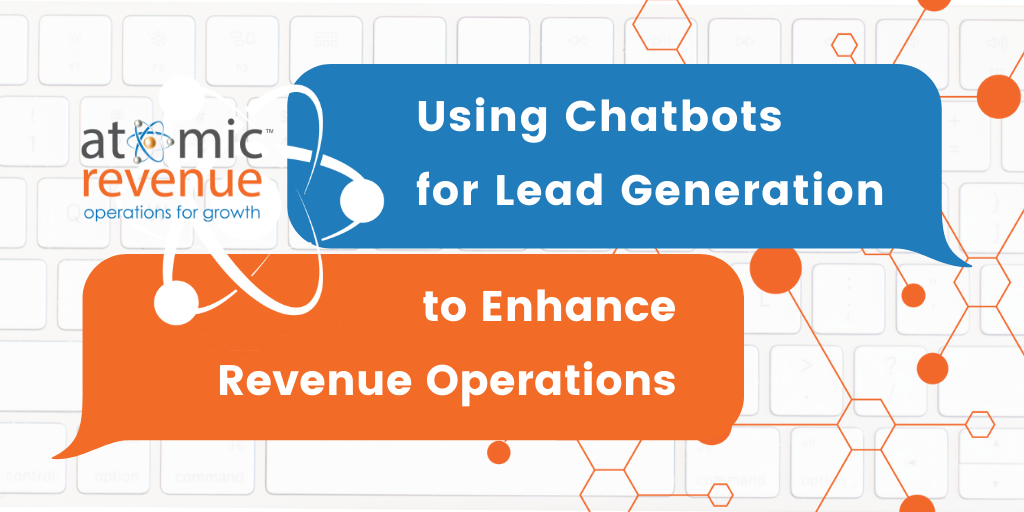
Chatbots are AI-powered conversational assistants created to communicate with customers without human intervention. Chatbots increase sales by an average of 67%, a crucial fact for any company’s revenue. Another important fact is that 69% of consumers prefer chatbots as a customer service channel. So how do you work them into your RevOps process?
Introduction: How to Use Chatbots for Lead Generation & Revenue Operations
If you're only slightly aware of Chatbots and their growing importance in customer acquisition, online marketing, and revenue operations, this post is for you.
Marketing Managers, CEOs, Directors of Marketing, and VPs of Customer Acquisition are responsible for testing and experimenting with new methods to drive organizational growth while meeting the changing needs of current, future, and past customers.
The most successful teams cooperate and collaborate to meet the challenges of the organization, and the responsibility is shared by all members of the team, from the CEO down to your freshest intern.
The challenge?
Today’s digital-first focus has created levels of distrust amongst customers. In response to the 6000+ brand messages the average consumer faces on a daily basis, psychological filters have prevented even the most stringent marketer from successfully delivering the right message, at the right time.
Today’s technologically savvy consumer has more options and more choices than ever in history and based on the amount of information available, it becomes every marketer's challenge to provide information in the right tone, in the right format, and in the right style to allow the customer to make a purchase decision on their terms.
Enter chatbots!
- Top chatbot influencers to follow
- Who are thought leaders in the chatbot space?
- 7 Things I Learned From Building An AI Chatbot For Leadership Development
In this post, you’ll learn:
- The rising importance of Artificial Intelligence (AI)
- What a Chatbot Is
- Chatbots and the Principles of AI
- How Atomic Revenue applies chatbots and revenue operations to drive efficiencies on behalf of our clients
You might be asking: What's In It For Me?
The Atomic Revenue team has the answer.
By reading this post and implementing the principles discussed, you’ll have the opportunity to:
- add value to your customers.
- increase the success of your revenue operations.
- win back your time, money, energy, and attention.
How Constant Customer Communication Has Evolved & Why It’s Important to Your Value Prop
As a professional responsible for increasing lifetime value and lowering customer acquisition costs (CAC), you might be aware of some of the challenges associated with the constant communication required to engage potential customers, namely the transition from marketing to sales, customer relations management, and Big Data.
The transition from marketing to sales can be difficult, considering the customer success team needs to ensure that 20% of your current customers effectuate against the 80% of the activity responsible for your organization’s revenues.
Call centers, account management, and relationship reinforcement overlap the flow between marketing and sales. The important jobs associated with customer relationship management offer important clues in communicating your organization's value proposition to buyers.
The goal of every organization is to add value to customers. Considering 2022’s “always-on” lifestyle, many organizations struggle with the knowledge that anyone and everyone has the opportunity to become a customer. The difference between marketing and sales today versus the days of yesteryear is Big Data.
Through data, we’ve learned that the number of touchpoints customers experience directly impacts how close or how far away they land from your increase in revenue. This is where chatbots add an extra layer of personal service.
What Is a Chatbot?
Machines, specifically computers, software, and mobile applications (apps) have helped to facilitate better and more efficient customer communications, and now bots or chatbots are becoming mainstream. These computer programs simulate human conversation through voice commands and/or text chats and were originally born in the 1960s.
Present-day development in chatbots has included learning algorithms, such as deep learning and neural networks which perform AI tasks like image recognition, natural language generation, speech recognition, and text-to-speech synthesis.
While the history of the chatbot is long, technologically savvy marketers, product specialists, and business owners recognize they offer a key bridge to developing relationships with customers, on their terms, but only if helpful and fully integrated to limit customer frustration.
- 4 billion people use messaging apps
- Chatbots can lower customer service costs
- 80% of respondents said one of their top frustrations with chatbots was being unable to get answers to simple questions
The changing landscape has meant that human/computer interaction has impacted the tide in terms of chatbots and their impact on marketing, sales, customer service, and the way we do business.
Chatbots offer an opportunity to increase revenue by thinking through the logic and rationale of the conversations required for a successful marriage of marketing and sales and customer acquisition and retention. The logistics of successful customer conversations and the touchpoints required for customer advocacy can now be automated with bots.
Per Gartner’s 2022 predictions, 70% of white-collar employees will interact with chatbots and conversational platforms daily by the end of 2022. This means if your organization hasn’t considered implementing a robust chatbot strategy for your lead generation efforts, you might get left in the dust.
How to Use Chatbots for Revenue Operations
- Customer Service: answer basic customer questions quickly
- Marketing Support: direct, one-on-one communication
- Human Resources: virtual assistant that automates comprehensive functions; communicates with potential candidates and new employees
- Customer Relations Management: data entry, faster data access, empower sales to focus on selling
- Sales Support: diversify lead gen strategy, create sales opportunities, improve sales efficiency without hiring more sales reps
Where AI Meets Personalized Conversation
Several different types of chatbots are currently available in the market. While each version offers unique sets of features, what they all share is the ability to replicate and analyze human dialogue.
Artificial Intelligence, or AI, offers modern-day communicators the help they need to share the load of customer engagement through conversations.
While most experts agree AI won’t ever 100% replace traditional conversations and human-to-human interaction, it does provide the chance to facilitate robust conversations, providing relevant information to you and your customers.
Narrowed through the lens of marketing, operations, customer success, and sales, chatbots leveraging computers or machines can replace low and mid-fidelity touchpoints which traditionally require ongoing human capital.
How Chatbots Can Impact Revenue Operations
Imagine your salespeople, marketers, and customer service specialists offering 24/7 help to potential and current customers. Chatbots provide business owners and organizations the ability to replicate human capital while driving efficiencies in the spirit of sales and revenue operations growth.
Bots typically answer several questions and document several touchpoints using your favorite Customer Relationship Management (CRM) platform to provide the information your customers require to make a decision.
This data is also important to provide your team with the context necessary to encourage customers to purchase from you or to move on to a more closely aligned prospect. While sometimes posed differently, more often than not, teammates answer the same questions, over and over again.
Websites, social media channels, messenger platforms, and Frequently Asked Questions (FAQ) pages help to alleviate some of the challenges of delivering the right information at the right time, but allowing customers to indoctrinate and educate themselves with a chatbot conversation during non-business hours creates an opportunity to lower customer service and acquisition costs while helping sales teams manage gaps in time.
Chatbots get to the heart of constant communication in a way that in-person teams cannot, thereby increasing customer satisfaction and potentially turning a happy customer into a customer advocate. Revenue operations is the process by which you create customer advocacy, which is the only way to consistently increase revenue and profitability. Chatbots can be another link in that process.
Getting Started With Chatbots: Atomic Revenues Process
Through time, trust and experience, customers have gotten more acclimated to engaging with computers and machines versus traditional human-to-human interaction. Technology has thus allowed teams to expand while driving internal business efficiencies and customer advocacy.
Atomic Revenue knows a thing or two about creating data-driven efficiencies and customer advocacy. As a leader in revenue operations and data-driven profitability, the data tells us that chatbots are here to stay.
- According to Tidio, 62% of consumers would prefer to use a customer service bot rather than wait for human agents to answer their requests.
This is why the Atomic Revenue team has been investing resources into providing chatbot solutions that assist our B2B clients with the revenue operations process, from lead generation and sales conversion to digital operations, people operations, and business operations, and ultimately, to customer advocacy.
.png?width=1600&height=900&name=Atomic%20Revenue%20Blog%20Graphics%20(3).png)
In Summary: Chatbots & RevOps
Now that you’ve learned a little about how and why to use chatbots for lead generation and enhancing the customer journey at your B2B organization, I hope it inspires you to take the next step by adding chatbots to your revenue operations process.
Here’s a quick summary of the post and some facts to walk away with:
- The average consumer receives an average of 6000+ messages/day.
- Today's marketing professionals are responsible for delivering their organization's message in the right tone, in the right format, and in the right style to allow the customer to make a purchase decision on their terms.
- Machines, specifically computers, software, and mobile applications (apps) have helped to facilitate better and more efficient customer communications.
What Is a Chatbot?
- Chatbots are computer programs that simulate human conversation through voice commands and/or text chats.
- Chatbots offer a key bridge to developing relationships with customers, on their terms, but only if helpful and fully integrated to limit customer frustration.
- 70% of white-collar employees will interact with chatbots and conversational platforms daily by the end of 2022.
Where AI Meets Personalized Conversation
- Chatbots include learning algorithms, such as deep learning and neural networks, which perform AI tasks like image recognition, natural language generation, speech recognition, and text-to-speech synthesis.
- AI won’t ever replace human-to-human interaction, but AI can replace low and mid-fidelity touchpoints.
How Chatbots Impact Revenue Operations
- Chatbots offer an opportunity to increase revenue by thinking through the logic and rationale related to the conversations required for a successful marriage of marketing and sales.
- Chatbots provide business owners and organizations the ability to replicate human capital.
- Chatbots get to the heart of constant communication in a way that in-person teams cannot, thereby increasing customer satisfaction and potentially turning a happy customer into a customer advocate.
- 62% of consumers would prefer to use a customer service bot rather than wait for human agents to answer their requests.
Learn More About Atomic Revenue Chatbot Services
If you’re reading this post, you probably already know the importance of combining multiple touchpoints and messages as related to your marketing, lead gen, and sales funnels. Remember, it typically takes up to 20 touchpoints to qualify a future customer. Why not offer a comprehensive chatbot to move prospects through the qualifying process and customers through the 7-stage buyer journey with less effort?
When you’re ready to learn more about Atomic Revenue’s budding chatbot products and services, we’re here for you. Feel free to reach out for a no-obligation conversation with one of our subject matter experts.
 About the Author
About the Author
Terence Latimer is a Digital Strategy & Operations Specialist at Atomic Revenue and the founder of Food Tribe, a software company committed to ending hunger by connecting good people to good food. Terence is a solutions architect, content specialist, data and analytics #blerd, and writer and entrepreneur based in Los Angeles. He has over 10 years of working with small, large, and enterprise-sized organizations in digital operations transformations, data and information communications, digital marketing, and revenue operations.






